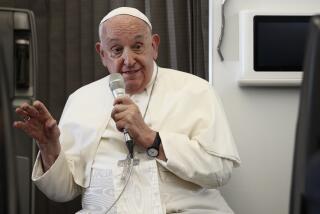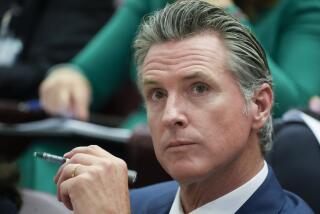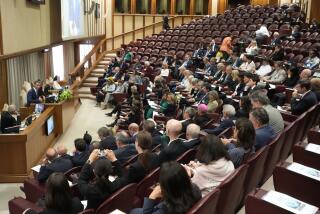Pope Ends U.S. Trip by Decrying Death Penalty
ST. LOUIS â Pope John Paul II, preaching an unpopular cause to U.S. Roman Catholics and their political leaders, on Wednesday issued his most direct appeal yet for an end to capital punishment in the United States.
Winding up his seventh visit to this country, the pope said the worldâs lone superpower has a moral responsibility to âdefend life.â Catholics, he added, should âproclaim the gospel of lifeâ by lobbying against the death penalty, which he called âcruel and unnecessary.â
âThe dignity of human life must never be taken away, even in the case of someone who has done great evil,â John Paul told more than 100,000 worshipers at a Mass at St. Louisâ riverfront convention complex. âModern society has the means of protecting itself without definitively denying criminals the chance to reform.â
Since 1977, when the Supreme Court reinstated the death penalty, 38 states have legalized the practice, and 500 prisoners have been executed. The U.S. is the only major Western democracy that applies the death penalty--a practice supported by about 70% of the public in recent opinion polls.
Although American Catholicsâ views on crime and punishment are in line with those of the overall population, the popeâs audience burst into applause after each sentence of his remarks on the subject.
A growing number of nations has abolished the death penalty or stopped using it in recent years, and John Paul said Wednesday that the trend is âa sign of hope.â He repeated his Christmas Day appeal for a âconsensusâ among world leaders to end the practice.
Catholic teaching once held that nations have the âright and dutyâ to punish criminals with âpenalties commensurate with the gravity of the crime, not excluding, in cases of extreme gravity, the death penalty.â
But in the 1995 encyclical âThe Gospel of Life,â John Paul all but closed any loophole. Modern means of punishing and preventing crime, he wrote, have made cases that justify the death penalty âvery rare, if not practically nonexistent.â
His sweeping condemnation of capital punishment Wednesday, part of a homily calling for a spiritual renewal in the next millennium, was his first lecture to a U.S. audience on the updated teaching. It came at the end of a six-day trip that took him to Mexico City and St. Louis.
âThe popeâs words are welcome news,â said Dan Misleh, policy advisor on nonviolent issues for the U.S. Catholic Conference in Washington. âSince 1995, the American Catholic clergyâs involvement in abolition movements has been huge, but so far it hasnât moved the Catholic rank and file or the politicians.â
John Paul has messaged U.S. governors more than a dozen times asking clemency for death row inmates; each time, he has been turned down. In California, new Gov. Gray Davis is a Catholic who supports the death penalty.
In apparent deference to the papal visit, Missouriâs Supreme Court last month did postpone the execution of Darrell Mease, who was to have died by lethal injection Tuesday, the day the pope arrived here. Mease, 52, has been on death row for nine years for the 1988 slaying of a couple and their grandson in a dispute over narcotics.
But papal spokesman Joaquin Navarro-Valls called the courtâs move of the execution date to Feb. 10 âa mockery.â
âWhat do you do?â he asked. âFirst, you are going to kill him, but then you give him a Valium and say, âWait.â And then after the pope is gone, you kill afterward. No! Whenever he is executed, the state must know that what it is doing is morally wrong.â
In preaching spiritual renewal, John Paul told audiences here and in Mexico that they must not only heed the churchâs teachings but also spread them to others.
One Catholic who took his message to heart was Mae Breadon, 76, who traveled from Cincinnati to attend Wednesdayâs Mass.
Breadon, who is retired from the Internal Revenue Service, said she has been arguing the popeâs case against capital punishment since 1995--among her friends and 13 children--with mixed results.
âWhen you have capital punishment, thereâs too much of a chance of killing innocent people,â she said. âPeople argue back that itâs a biblical tradition--an eye for an eye. But I tell them that weâve become too cruel, that everything we do to kill people makes life for others worth less.â
About 74,000 worshipers filled the Trans World Dome to hear the yellow-robed pope say Mass in the end zone beneath a 45-foot-high aluminum replica of St. Louisâ famed Gateway Arch.
Tumultuous cheering greeted his popemobile as it entered the sports arena after passing through five adjacent exhibition halls in the Americaâs Center complex. An additional 26,000 people in those halls followed the Mass on giant video screens, organizers said, billing it as the largest indoor gathering held in the United States.
In contrast to Mexico City, where millions of admirers gathered along his motorcade routes, St. Louis, whose metropolitan area has a population of 650,000, was restrained. Crowds on the street were thin; organizers said that perhaps their warnings of downtown chaos and traffic jams had kept people away.
John Paul spent 30 hours in St. Louis. He arrived after delivering a landmark message in Mexico City calling for a ânew evangelizationâ that would bring peace, economic justice and solidarity to the peoples of North and South America.
Echoing themes from that message at the televised Mass, he beckoned Catholics who have abandoned their faith to âexperience the joy of returning to the Fatherâs house.â He demanded âan end to every form of racismâ and repeated the condemnation of abortion and euthanasia that he had delivered Tuesday in President Clintonâs presence.
Later Wednesday, at evening prayers in the Cathedral Basilica of St. Louis attended by 2,000 people, including Vice President Al Gore, he said: âAnd so, America: If you want peace, work for justice. If you want justice, defend life. If you want life, embrace the truth--the truth revealed by God.â
As the prayer service drew to a close, two dozen leaders of various religions--Judaism, Hinduism, Islam, Mormonism, Eastern Orthodoxy and others--presented the pope with a banner symbolizing interfaith cooperation and filed past to clasp John Paulâs hands.
âIt was very beautiful,â said Lama Rinchen Phuntsok, a Tibetan Buddhist monk in maroon robes. âWar is more wild in the world these days, so itâs very important to have all the spirituals come together and pray together.â
Emphasizing the popeâs commitment to dialogue among the faiths, Rabbi Robert Jacobs, 90, opened the prayer service with a reading from the prophets. Religious leaders said it was the first time they were aware of that a rabbi had led an evening prayer service in a basilica, much less at a papal event.
Another Jewish leader called the papal Mass to order Wednesday morning with blasts from the shofar, a ramâs horn traditionally blown on the Jewish High Holy days.
Praising Jacobsâ participation, the Rev. John Anderson, pastor of a local Baptist church, said the evening service represented âone of the broadest cross sections of religious communities ever assembled in the United States,â and he promised that the popeâs language calling all participants âbrothers and sistersâ would continue to bring people together long after the pontiffâs visit ended.
âAny time people get together and have an experience like this,â agreed Sally Marble of Missouriâs Christian Leadership Forum, âitâs always bound to affect you.â
More to Read
Sign up for Essential California
The most important California stories and recommendations in your inbox every morning.
You may occasionally receive promotional content from the Los Angeles Times.










